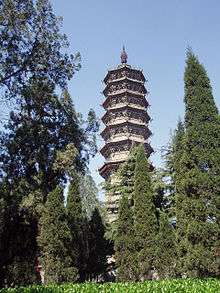Pagoda of Bailin Temple
Coordinates: 37°44′51″N 114°46′41″E / 37.74750°N 114.77806°E

The Pagoda of Bailin Temple (Chinese: 从谂禅师舍利塔; pinyin: Cóngshĕn Chánshī Shĕlìtǎ or Chinese: 赵州塔; pinyin: Zhàozhōu Tǎ), is located in Shijiazhuang, Zhao County, Hebei province, China. It is an octagonal-based brick Chinese pagoda built in 1330 during the reign of Emperor Wenzong, ruler of the Mongol-led Yuan Dynasty (1271–1368).
Bailin Monastery
The Bailin Monastery (Cypress Trees monastery,[1]) surrounding the pagoda, was built in the second century CE, and called Guan Yin Monastery.[2] Its most prominent abbot was the famous Chan master Zhaozhou (Joshu),[1] who is well known for the Mu-koan.[1]
The temple was in ruin long before 1949.[3] In 1988, Jing Hui was persuaded to take over the Hebei Buddhist Association, and start rebuilding Bailin Monastery.[3] Jing Hui is a student[3] and dharma successor[4] of Hsu Yun, but has also adopted the Humanistic Buddhism of Taixu.[3][note 1][note 2]
Pagoda
The seven story pagoda stands at a height of about 40 m (131 ft), built on a stone foundation. The lower section of the pagoda is a brick sumeru pedestal, which features two rows of intricate carvings that include artwork of musicians, celestial guardians, animals, and peonies. The first story of this solid brick pagoda features a facade of doors and windows, as well as columns, rafters, and brackets. Above this are seven tiers of eaves.
The design style of this Yuan Dynasty era pagoda follows the tradition of the Liao Dynasty and Jin Dynasty, which were Khitan and Jurchen dynasties that ruled northern China before Kublai Khan established the Yuan.
Notes
References
- 1 2 3 Caifang Zhu (2003), Buddhism in China Today: The Example of the Bai Lin Chan Monastery
- ↑ Caifang 2003.
- 1 2 3 4 Feuchtwang 2010, p. 189.
- 1 2 The Dharma Lineage of my Master: Grand Master JING Hui, Abbot of Bai-lin (Cypress Forest)
- ↑ A short biography of Chan Master Jinghui
- ↑ Jaysquare, Introduction
- ↑ Biography (at bottom of the page)
- ↑ zhaozhou-chan, BIOGRAPHY OF DANIEL ODIER
Sources
- Zhu, Caifang (2003), Buddhism in China Today: The Example of the Bai Lin Chan Monastery. In: Perspectives, Volume 4, No.2, june 2003 (PDF)
- Feuchtwang, Stephen (2010), The Anthropology of Religion, Charisma and Ghosts: Chinese Lessons for Adequate Theory, Walter de Gruyter
Further reading
- Yang, Fenggang; Wei, Dedong (n.d.), THE BAILIN BUDDHIST TEMPLE: THRIVING UNDER COMMUNISM (PDF)
External links
| Wikimedia Commons has media related to Bailin Temple (Hebei). |